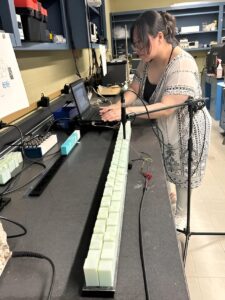
Terry Loring, distinguished professor of mathematics and statistics, published and co-authored a new research piece involving his research on K-theory with the major advances in applications to critical problems in physics.
The study titled, “Revealing topology in metals using experimental protocols inspired by K-theory,” was published in Nature Communications. Loring used mathematical properties of K-theory to help advance the understanding of topological materials in the physics world.
The main focus of the study was to discover how electricity, sound, or light can be trapped in a portion of a material. “This experiment was done in what is called a meta-material, built from individual sound resonators coupled in a fashion that mimics how atoms can come together to form a crystal. Three-dimensional printing allows us to make customized resonators that we join in a precise way to make the physics match the mathematics,” explained Loring. The study was part of a larger project that covered many areas of physics.
According to Loring, there are different forms of K-theory that arise in many different mathematical fields, however, the form of K-theory that he used in this study was focused on being best suited for studying matrix models of physical systems.
Loring explains that matrices are simply square tables of numbers, with a peculiar rule for how two matrices are multiplied. This rule has an asymmetry in it that leads to having AB and BA sometimes being very different, meaning that the commutative law for multiplication is violated.
“Physicists like Heisenberg realized that matrices are terrific at modeling uncertainty in molecular- and atomic-scale physics. K-theory can tell us when certain matrices can be connected except by a path that goes through what we call a singular matrix. This guaranteed singularity turns out to have an important meaning when the matrices come from models of physical systems,” Loring said.
The researchers were mainly looking at topological materials which include topological insulators. A topological insulator can have an index associated to it, which is a number computed using K-theory. If a device is built from two topological insulators that each have a different index, there is guaranteed to be a conducting region where the two materials come together.
“This conducting region exactly corresponds to where a certain matrix goes singular. To demonstrate this fact we use results about determinants one learns in linear algebratogether with the intermediate value theorem that people learn in their first calculus class,” said Loring.
This research is attempting to advance the theory of topological metals. Topological metals mix up conducting and insulating properties in very confusing ways. Loring and team built an acoustic crystal that had a specific pattern, they then deliberately broke the pattern in the middle thus inserting a defect in the system.
“During the experiment, and computer simulations, we were able to show how sound can get trapped at the defect. The hope is that it teaches us how to better trap light in small-scale photonic devices, and more generally start to manipulate light in a similar way to how electronic circuits manipulate electricity. There are advantages to moving information with light, as this can sometimes eliminate/reduce the energy wasted by the heat associated with electronics,” Loring stated.
Another part of the experiment which was more delicate included modifying the acoustic resonators by a formula from K-theory. The modified system removed the metallic properties in many parts of the crystal, isolating the binding metallic nature of the defect.
“Of course our acoustics system is not a metal, but shares mathematical properties with metals that harbor topology in their electronic structure. The hope is we will be able to devise experimental probes of photonic and electronic systems that bring the K-theory off the blackboard and into the lab,” explained Loring.
Mathematics was central to the design of this experiment. The project began with a discussion of formulas in K-theory that might lead to a matrix that can describe the energy in an acoustic system.
“We started with the analysis we would use to explain the system and then built a system that could be analysed this way. This backwards flow is somewhat common in the field of ‘topological physics’ where clean formulas in math suggest the search for physical systems that match that formula,” Loring stated.
In finding, Loring and his team discovered that new mathematics can classify very local patches of material as insulating or conducting. Loring points out that initially it was not clear if this classification had any meaning that a physicist would care about.
“This experiment showed that we can manufacture materials where this local classification is physically meaningful. While this material has no practical application, it is expected that materials and devices will be discovered or manufactured that have these local variations and that these local variations will give us even more control over light and electricity than we now enjoy.”
For more such insights, log into our website https://international-maths-challenge.com
Credit of the article given to Dani Rae Wascher, University of New Mexico

 Two weeks ago, a modest-looking paper was uploaded to the arXiv preprint server with the unassuming title “On the invariant subspace problem in Hilbert spaces.” The paper is just 13 pages long and its list of references contains only a single entry.
Two weeks ago, a modest-looking paper was uploaded to the arXiv preprint server with the unassuming title “On the invariant subspace problem in Hilbert spaces.” The paper is just 13 pages long and its list of references contains only a single entry.